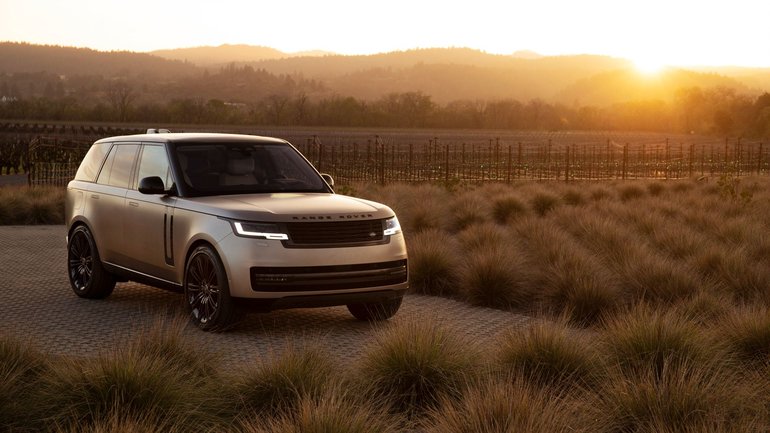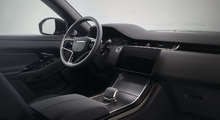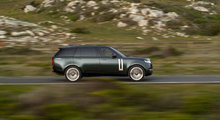Understanding Land Rover's MLA-Flex Platform: The Foundation for Current and Future Luxury
November 15 2025,

Modern vehicle architecture determines more than just structural capability. Platform engineering influences refinement, accommodates multiple powertrain technologies, and establishes the foundation for advanced chassis systems. Land Rover's Modular Longitudinal Architecture (MLA-Flex) serves this role across the brand's luxury lineup, providing the technical basis for vehicles ranging from current plug-in hybrids to the forthcoming all-electric Range Rover.
For buyers evaluating Land Rover's product range, understanding MLA-Flex clarifies how the brand can offer such diverse powertrains within similar vehicle forms and explains the engineering approach underlying the refinement and capability these vehicles deliver.
Platform Fundamentals: Material Strategy
MLA-Flex employs strategic material selection, using the right material for each structural component based on specific engineering requirements. High-strength steel appears in areas requiring maximum structural integrity, particularly around battery mounting points and impact zones. Aluminum components reduce weight where maximum strength isn't required, optimizing the overall weight-to-stiffness ratio.
This mixed-material approach delivers torsional stiffness up to 50 per cent higher than previous-generation Land Rover architectures. Structural rigidity provides multiple benefits: it serves as the foundation for suspension systems to work effectively, reduces vibration transmission into the cabin, and creates the solid, substantial feel associated with luxury vehicles.
The steel front bulkhead features a closed-section design that creates a double-glazing effect for noise isolation. This structural element alone reduces low-frequency vibration and road noise transmission by 24 per cent compared to previous architectures, establishing baseline refinement before additional sound-deadening materials are applied.
Accommodating Multiple Powertrains
MLA-Flex's defining characteristic is its flexibility to accommodate internal combustion, plug-in hybrid, and battery-electric powertrains within a single structural framework. This capability required engineers to design the platform from its inception to handle the specific requirements of each technology.
PHEV Integration
Plug-in hybrid applications require substantial battery capacity located within the vehicle's structure. MLA-Flex positions the 38.2 kWh battery pack under the cabin floor, within the wheelbase. This central location maintains optimal weight distribution while preserving cargo capacity and ground clearance.
The battery casing uses high-strength Boron steel engineered to withstand extreme off-road conditions, including the vehicle's full weight balanced on a single axle. For vehicles designed to maintain all-terrain capability regardless of powertrain, this structural protection was non-negotiable.
Thermal management systems integrated into the platform structure regulate battery temperature across operational conditions. In Quebec's climate extremes, from summer heat to winter cold, these systems maintain optimal battery performance and longevity.
BEV Preparation
The forthcoming Range Rover Electric demonstrates MLA-Flex's battery-electric capabilities. Accommodating a BEV requires managing significantly greater battery mass compared to PHEVs, necessitating additional structural reinforcement and different weight distribution strategies.
The 800-volt electrical architecture planned for the Range Rover Electric integrates into MLA-Flex's design, supporting high-power charging systems and advanced thermal management. The platform's structural rigidity becomes particularly important in BEV applications, where battery mass increases vehicle weight substantially.
Mild-Hybrid and ICE Applications
MLA-Flex also supports traditional internal combustion powertrains with 48-volt mild-hybrid systems. These applications benefit from the same structural advantages as electrified variants while accommodating conventional drivetrain layouts.
The platform's longitudinal engine orientation maintains Land Rover's traditional all-wheel-drive architecture, with power transfer through a central differential to front and rear axles. This configuration supports the brand's capability requirements, distributing torque effectively across varied terrain conditions.
Structural Engineering and Refinement
Platform stiffness directly influences vehicle refinement. A rigid structure allows suspension systems to control wheel movement precisely, maintains body stability during cornering, and reduces unwanted flexing that can create squeaks, rattles, or harshness.
MLA-Flex achieves its rigidity through strategic reinforcement at critical stress points. Three reinforcement rings at the A, C, and D pillars form the core structure. Additional strengthening around the front door openings creates a fourth ring, further enhancing torsional stiffness.
This rigidity remains consistent even with a full-length panoramic roof, a feature that typically compromises structural integrity. The engineering approach allows Land Rover to offer large glass roofs without sacrificing the solid feel expected in luxury vehicles.
Suspension Integration
The platform's design accommodates Land Rover's Electronic Air Suspension systems, allowing ride height adjustment and adaptive damping. The structural rigidity provides a stable foundation for these systems to work effectively, maintaining precise control over wheel motion.
Air suspension mounting points integrate directly into the platform structure, distributing suspension loads across reinforced areas. This approach allows the suspension to manage the vehicle's weight and handle rough terrain without transferring excessive stress into the body structure.
For vehicles operating in Montreal's varied conditions, from smooth highways to potholed urban streets, the suspension's ability to adapt matters significantly. The platform's rigidity ensures that suspension adjustments produce consistent results regardless of road surface quality.
Weight Distribution and Handling
MLA-Flex's battery placement strategy in PHEV applications maintains near-optimal weight distribution. Positioning heavy components centrally and low in the chassis reduces the center of gravity, improving handling dynamics and roll resistance during cornering.
This low center of gravity benefits both on-road dynamics and off-road capability. During highway driving, it reduces body roll and improves stability. In off-road situations, it enhances stability on uneven terrain and reduces the risk of rollovers on steep side slopes.
The platform accommodates Land Rover's all-wheel-drive systems without compromising weight distribution. Power distribution between front and rear axles adjusts dynamically based on traction conditions, with the platform's structure supporting the mechanical components required for this capability.
Acoustic Engineering
Beyond structural stiffness, MLA-Flex incorporates dedicated acoustic engineering. Sound-deadening materials apply strategically throughout the structure, targeting specific frequency ranges that would otherwise transmit into the cabin.
The platform design minimizes noise transmission paths from suspension mounting points, engine mounts, and drivetrain components. Isolation strategies interrupt vibration transfer before it reaches the passenger compartment.
For electric and plug-in hybrid applications, where engine noise doesn't mask road noise and wind noise as effectively, these acoustic treatments become particularly important. The platform provides the quiet foundation necessary for electric vehicles to deliver the refined character buyers expect from Range Rover products.
Manufacturing Considerations
MLA-Flex's modular design allows Land Rover to produce multiple vehicle variants on shared manufacturing lines. This flexibility provides production efficiency while maintaining vehicle-specific characteristics through different component specifications.
The platform accommodates different wheelbase lengths without fundamental structural changes, allowing both standard and long-wheelbase Range Rover variants to use the same basic architecture. This commonality reduces manufacturing complexity while maintaining each vehicle's distinct character.
Quality control benefits from the platform's design. Standardized mounting points and structural elements allow consistent assembly processes across different models, improving production precision and reducing variation between individual vehicles.
Future-Proofing Through Flexibility
MLA-Flex's design accommodates technologies not yet implemented across the current lineup. The structural provision for high-voltage electrical systems, advanced battery chemistries, and evolving drivetrain technologies provides a foundation for future product development.
This forward-looking approach matters for buyers concerned about technological obsolescence. Vehicles built on MLA-Flex use architecture designed to support ongoing innovation rather than serving as a transitional solution until dedicated electric platforms arrive.
The Range Rover Electric's 800-volt architecture demonstrates this capability. When the vehicle launches in 2026, it will implement technology unavailable when MLA-Flex was initially developed, yet the platform accommodates these systems without fundamental redesign.
Current Applications
MLA-Flex currently underpins the Range Rover, Range Rover Sport, and will support the forthcoming Range Rover Electric. Each vehicle uses the platform differently, with unique suspension calibrations, powertrain configurations, and structural specifications appropriate to its role in the lineup.
The Range Rover prioritizes refinement and luxury, using MLA-Flex's capabilities to deliver the quietest, most comfortable experience in the lineup. The Range Rover Sport takes the same platform and applies performance-focused suspension tuning and chassis settings, demonstrating the architecture's flexibility.
Implications for Montreal Drivers
Understanding MLA-Flex helps buyers make informed decisions about Land Rover vehicles. The platform's PHEV battery placement explains why plug-in hybrid models maintain full cargo capacity. Its structural rigidity clarifies how Land Rover achieves refinement levels appropriate to luxury positioning.
For Quebec's climate conditions, the platform's thermal management capabilities matter significantly. Battery systems engineered into the structure from the design phase perform more reliably than aftermarket adaptations, important for year-round operation in variable temperatures.
The platform's accommodation of multiple powertrains provides buyers with genuine choice. Whether selecting a mild-hybrid, plug-in hybrid, or planning for a future battery-electric vehicle, MLA-Flex supports each technology competently.
Maintenance and Longevity Considerations
Platform engineering influences long-term durability. MLA-Flex's structural rigidity reduces chassis flex that can lead to premature wear of body panels, door seals, and interior components. This rigidity maintains the tight, solid feel luxury buyers expect even after years of operation.
The platform's corrosion protection matters particularly in Quebec, where road salt exposure is severe. Aluminum components receive protective treatments, and steel elements use coatings designed for harsh climates. These measures extend structural lifespan in challenging operating environments.
Service access considerations integrated into the platform design allow technicians to maintain and repair vehicles efficiently. Battery systems in PHEV applications can be accessed for service without extensive disassembly, reducing maintenance costs and complexity.
Visit Decarie Land Rover for Platform Demonstration
The engineering underlying a vehicle often remains invisible during casual observation. Decarie Land Rover in Montreal can provide detailed explanations of how MLA-Flex influences the vehicles you're considering, whether evaluating current models or planning for future purchases.
Our team understands the technical foundations that make these vehicles perform as they do. Visit us to learn how platform engineering translates into the refinement, capability, and flexibility that defines the modern Land Rover lineup.





